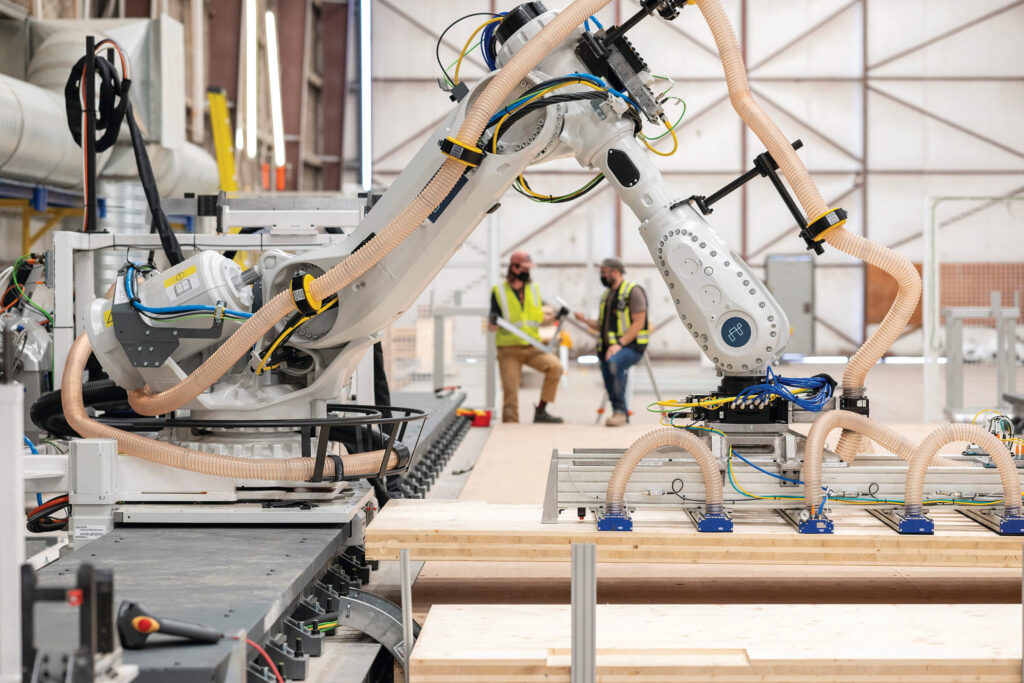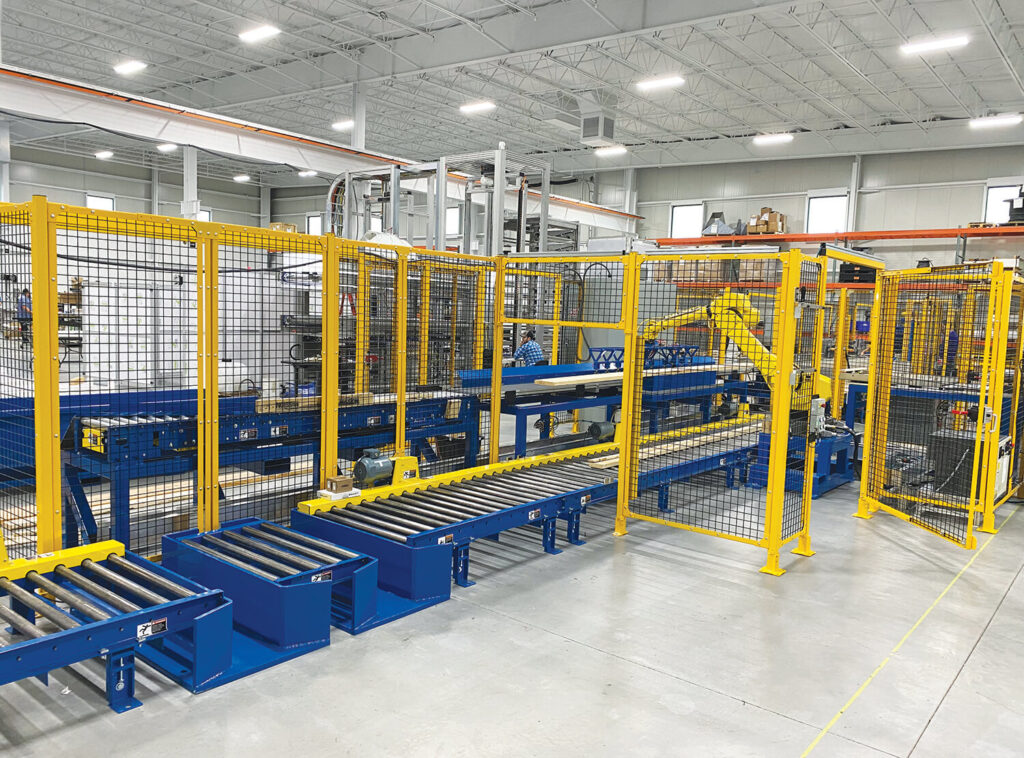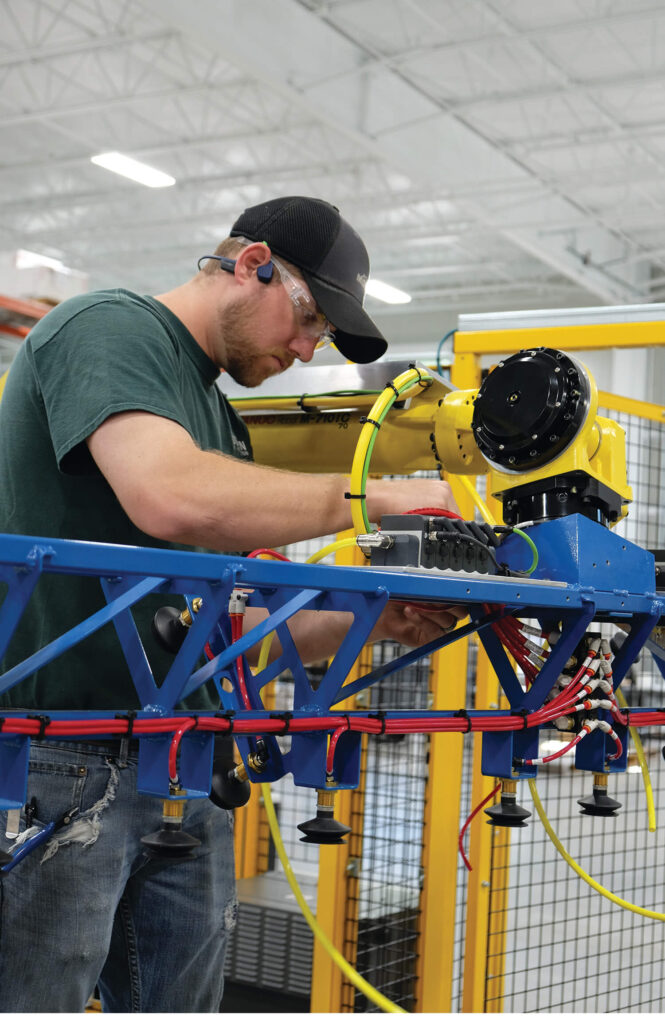How can you determine if robots will yield a positive return for your factory? By going through the following steps.
• Although you will eventually want the help of a robotics integrator, you should devote some upfront time to making your process more efficient. This will save time and money and will help ensure a successful result.
• Before designing a robotics system for any factory, the integrator will need a lot of data about the current operations. That includes data compiled by the company as well as by the integrator during a site visit.
• Employee buy-in can make or break a robotics effort. A good integrator will want to discuss the effort with people at all levels, from managers to line workers.
Are you thinking about introducing robotics into your module, panel or truss plant? Unless you have the budget to hire an in-house robotics expert, you will want to get an assessment by a robotics integrator. The assessment will tell you if robots make sense, where you might want to use them, and how much they will cost.
The assessment will be more fruitful, and possibly less costly if you do some prep work ahead of time before contacting an integrator. What questions should you ask yourself and what information should you gather? To find out, we talked with three robotics integrators: Ryan Lillibridge at Mission Design and Automation in Michigan; William Gibbs at Modica in Washington State; and Brent McPhail at Brave Control Solutions in Ontario and Michigan.
Get Lean first
Before looking at robotics, McPhail recommends trying to improve your processes with standard — and relatively low cost — Lean practices.
Questions to ask yourself include:
- Can materials be reorganized to reduce the distance employees need to walk to bring materials to workstations?
- How much time do employees waste waiting for one step to be completed before the next one starts?
- Are the steps in your processes arranged in the most efficient order?
- Are materials wasted during your process?
- Are people getting in one another’s way?
- Can you improve traffic flow in your facility?
(Editor’s note: Daniel Small of DaVinci Innovation writes an excellent monthly column for this magazine that details how factory owners can implement these and other Lean practices.)
If you succeed in Leaning your processes, you may decide not to go any further. However, if you believe that robotics can offer further improvements, you need to start gathering data.
Data Acquisition
Gathering and analyzing data is essential to figuring out if robotics makes financial sense. Here are some key questions. You can answer them yourself, or with an integrator.

Where are your recurring costs?
This is an important first step to determining where robotics will offer the best payoff. Will you get a better ROI by having articulated robots assemble walls or having AMRs (Autonomous Mobile Robots) moving materials around your plant? Before answering this question, the manufacturer needs to have calculated the costs incurred by each process in the factory, from framing floors and wall panels to installing cabinets.
How much work these calculations require will vary with the company’s financial sophistication. “Some companies already know how much it costs to put each nail into each segment of a wall,” Lillibridge says. “Others know how much money’s coming in, and how much they pay vendors, but they’re not able to tell you what they are spending on each step.”
What are your opportunity costs?
It’s also important to capture the opportunity costs of not adding robotics to your plant.
McPhail’s team starts by calculating the labor cost per product (panel, module or finished house) given the current production rate, as well as any material waste. Then they estimate how much additional product can be manufactured with robotics, along with the reduction in labor needs and waste. Finally, after factoring in the cost of purchasing, installing and operating the robots, they calculate the added profit.
“That’s your opportunity cost,” McPhail says.
What are your employee-related costs?
Lillibridge recommends calculating how much workers’ compensation claims are costing you as well as the cost to acquire each new employee. Also important, but more difficult to quantify, is the value of employee satisfaction.
Robots not only reduce staffing needs, but they can also make employees’ jobs easier and more satisfying. That will make them more productive and will reduce turnover.
What are your motivations?
Lastly, you need to clarify why you are considering a robotics investment.
Honestly answer questions like these:
- Why do you feel the need to do things differently? Perhaps, for example, you are hoping that robotics will reduce your staffing needs.
- What problem are you trying to solve or what goal are you trying to reach? You may have a target number of extra units you could easily sell if you could manufacture them.
- Is the main reason that you see other factories using robotics and find yourself with a bad case of FOMO (Fear of Missing Out)?
Some businesses can answer these questions without help. Eventually, however, any business that’s serious about introducing robotics (but that doesn’t have in-house expertise) will need an integrator.
Contacting The Integrator

A robotic system co-developed by Brave Control Solutions and Intelligent City is placing a mass timber panel for assembly at the Intelligent City manufacturing facility in Vancouver, BC.
An integrator will need to understand the details of your business, including all your answers to the above questions. They will also want to make sure your budget matches your goals. Are you figuring on spending $50,000, $500,000, or $1 million on the robotics effort?
If a back-of-the-envelope calculation indicates that robotics isn’t financially realistic at this point—which can be the case for a start-up—the integrator may suggest re-evaluating the situation after some time, or after a certain amount of revenue is reached.
But if the numbers look positive for robotics, the integrator will want to look at your processes in more detail.
Facility Visit
Lillibridge says it’s important for an integrator to visit a facility that’s a candidate for robotics, and to talk with people in the C-suite as well on the shop floor. To ensure candid answers and confidentiality, the integrator and the employees will sign mutual non-disclosure agreements.

Questions the integrator might ask in the C-suite include:
- What keeps you up at night?
- What do you feel automation will help you achieve?
- How are you managing your workforce and talent pool?
- How is your employee turnover rate?
- Has the labor shortage affected your product?
- How do you determine success?
- What does success look like to you a year from now? 5 years from now?
- How will you accomplish your goals?
Questions the integrator might ask employees on the shop floor include:
- What are some tools that would make your job easier?
- What tasks do you spend the most time on?
- What are things you do to ensure you make a good product that wasn’t explained to you when you started?
- What are the bottlenecks in your process that keep you from performing to the speed/efficiency/quality you want?
- Are employees ever physically injured on the job in a position that could be assisted using automation?
These interviews are crucial. “There needs to be buy-in from all levels of the company. Even a small shop with a single owner and a handful of employees who are all excited about introducing robotics can be a very good fit.” Lillibridge explains. “On the other hand, a corporate-driven initiative without support at the plant is usually not accepted well.”
Engineering Study
The integrator will also do what Lillibridge calls an engineering study. This is an in-depth look at every work process, from hanging doors to installing ducts, to painting walls and loading modules on trucks.
The integrator will record how long each step takes and how many people it involves. And they will look at how much skill is needed at each step. For example, wiring a home requires more skill than moving lumber and tools around (although the latter is more physically demanding).
They’ll also note which tasks employees describe as boring, physically demanding, or otherwise undesirable. (Employees will often welcome automating these tasks.)
Perhaps surprisingly, the slowest processes aren’t always the best ones to automate. If a task requires skills that are hard for robots—such as plumbing or wiring—it’s unlikely to be the right choice.
Also, do you have the required floor space, and if not, can you add it? The square footage needed for robotics to assemble components like wall panels is much bigger than for workers doing it by hand.

A material handling robot that picks boards from a conveyor and places them into a kit.
The time needed to complete the engineering study can vary from a few days to a few months. It will depend on the size of the facility and the amount of data the company has already gathered.
Likely Spots for Robotics
When deciding where to implement robotics Gibbs advises starting with The Three Bs: Bottlenecks, Budgets, and Backaches.
Bottlenecks aren’t always obvious. Although a particular part of a process may seem to be causing a Bottleneck, data analysis may reveal otherwise. The root cause may even be earlier in the process, but it doesn’t become apparent until a later step.
Budget is always top of mind, and an integrator will know which tasks are more difficult — and thus more expensive — for a robot to execute. Steps that are easy for robots to perform are more likely places to introduce them than more difficult ones.
Backache is obviously caused by heavy lifting. This could include things like lifting cabinets. While strenuous work is easy to spot, Gibbs notes that “ergonomic and repetitive stress issues are less obvious Backaches. Sometimes assembly steps require dextrous motions that don’t seem painful or dangerous, but when repeated thousands of times can cause serious and lasting injuries.” Examples include continually bending over to drive nails or screws.
Introducing robotics to reduce the risk of injury improves daily life for employees, and you’re more likely to retain them. Lillibridge adds that “if you reduce the physical requirements for a job, you automatically increase the labor pool so more people can apply.”
Mistakes to avoid
Lillibridge sees two main mistakes that companies make when implementing robotics. “The first is skipping the engineering study or buying something off-the-shelf that doesn’t really help you,” he says. Ready-to-use robots marketed to the construction industry include robotic welding systems for structural steel fabricators and screwdriving cobots. (A cobot is a that works alongside and in cooperation with a human worker.)
The second is not having buy-in across the organization. “A robotics initiative might be corporate-driven with no consultation with the people working on the shop floor. Or a plant might be enthusiastic, but corporate’s not on board. Either way is a recipe for failure,” Lillibridge says.
It can also be a mistake to go all-in at the beginning. There are benefits in automating one or a handful of processes and then expanding gradually will reduce sticker shock, and give the team time to learn and adjust, Lillibridge says.
The gradual approach also allows you to see how things go and determine where to take the next step towards introducing more robotics. Lillibridge suggests that a good place to start might be to “use a light-payload robotic arm to move cut boards from one sizing bin to another, helping to kit individual pieces that need to be assembled together.”
McPhail also says it’s also important to consider the total cost of ownership. Don’t overlook the maintenance, the material precision requirements, and the technicians you will need to hire.

Worker installing pneumatic hoses onto a material handling robot.
And make sure the robotics you choose will be able to adapt to future changes in your product line. You may make a few different wall panels now, but it’s an advantage if your system is flexible enough to manufacture a broader range in the future. A robotic system should have a lifespan of at least 10 years. “If future changes in your product can’t be accommodated by your robotics, then you’re looking at buying a new system or upgrading your current one earlier than expected,” McPhail says.
Increasing Productivity
As noted earlier in this article, upfront costs for a robotic system can be high, but what counts is their impact on the bottom line. “If a system can increase an employee’s output by 4 or 5 times, the ROI becomes very compelling,” McPhail says. If expensive robots make it possible for the manufacturer to sell enough additional products to cover the cost and raise profits, “buying them becomes an easy decision.”
Lillibridge adds that we need to build homes faster to meet the demand for housing and that to meet that demand we need more productive housing factories. “If robotics can help raise our industry’s productivity,” he says, “that would make a lot of people happy.”







